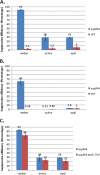Evidence that the supE44 mutation of Escherichia coli is an amber suppressor allele of glnX and that it also suppresses ochre and opal nonsense mutations
- PMID: 20833812
- PMCID: PMC2976463
- DOI: 10.1128/JB.00474-10
Evidence that the supE44 mutation of Escherichia coli is an amber suppressor allele of glnX and that it also suppresses ochre and opal nonsense mutations
Abstract
Translational readthrough of nonsense codons is seen not only in organisms possessing one or more tRNA suppressors but also in strains lacking suppressors. Amber suppressor tRNAs have been reported to suppress only amber nonsense mutations, unlike ochre suppressors, which can suppress both amber and ochre mutations, essentially due to wobble base pairing. In an Escherichia coli strain carrying the lacZU118 episome (an ochre mutation in the lacZ gene) and harboring the supE44 allele, suppression of the ochre mutation was observed after 7 days of incubation. The presence of the supE44 lesion in the relevant strains was confirmed by sequencing, and it was found to be in the duplicate copy of the glnV tRNA gene, glnX. To investigate this further, an in vivo luciferase assay developed by D. W. Schultz and M. Yarus (J. Bacteriol. 172:595-602, 1990) was employed to evaluate the efficiency of suppression of amber (UAG), ochre (UAA), and opal (UGA) mutations by supE44. We have shown here that supE44 suppresses ochre as well as opal nonsense mutations, with comparable efficiencies. The readthrough of nonsense mutations in a wild-type E. coli strain was much lower than that in a supE44 strain when measured by the luciferase assay. Increased suppression of nonsense mutations, especially ochre and opal, by supE44 was found to be growth phase dependent, as this phenomenon was only observed in stationary phase and not in logarithmic phase. These results have implications for the decoding accuracy of the translational machinery, particularly in stationary growth phase.
Figures



Similar articles
-
Complete set of orthogonal 21st aminoacyl-tRNA synthetase-amber, ochre and opal suppressor tRNA pairs: concomitant suppression of three different termination codons in an mRNA in mammalian cells.Nucleic Acids Res. 2004 Dec 1;32(21):6200-11. doi: 10.1093/nar/gkh959. Print 2004. Nucleic Acids Res. 2004. PMID: 15576346 Free PMC article.
-
Nonsense suppression in archaea.Proc Natl Acad Sci U S A. 2015 May 12;112(19):6015-20. doi: 10.1073/pnas.1501558112. Epub 2015 Apr 27. Proc Natl Acad Sci U S A. 2015. PMID: 25918386 Free PMC article.
-
A temperature-sensitive mutant of Escherichia coli that shows enhanced misreading of UAG/A and increased efficiency for some tRNA nonsense suppressors.Mol Gen Genet. 1984;193(1):38-45. doi: 10.1007/BF00327411. Mol Gen Genet. 1984. PMID: 6419024
-
Reversion of argE3 to Arg(+) in Escherichia coli AB1157 -an informative bacterial system for mutation detection.Acta Biochim Pol. 2010;57(4):479-85. Epub 2010 Oct 27. Acta Biochim Pol. 2010. PMID: 20978633 Review.
-
Nonsense suppression in mammalian cells.Biochimie. 1996;78(11-12):1007-15. doi: 10.1016/s0300-9084(97)86724-7. Biochimie. 1996. PMID: 9150879 Review.
Cited by
-
A simple technique for suppressor detection in Escherichia coli.FEMS Microbiol Lett. 2016 Oct 1;363(19):fnw228. doi: 10.1093/femsle/fnw228. FEMS Microbiol Lett. 2016. PMID: 27682418 Free PMC article.
-
High-Throughput Sequencing of Phage Display Libraries Reveals Parasitic Enrichment of Indel Mutants Caused by Amplification Bias.Int J Mol Sci. 2021 May 24;22(11):5513. doi: 10.3390/ijms22115513. Int J Mol Sci. 2021. PMID: 34073702 Free PMC article.
-
A comprehensive, high-resolution map of a gene's fitness landscape.Mol Biol Evol. 2014 Jun;31(6):1581-92. doi: 10.1093/molbev/msu081. Epub 2014 Feb 23. Mol Biol Evol. 2014. PMID: 24567513 Free PMC article.
-
G673 could be a novel mutational hot spot for intragenic suppressors of pheS5 lesion in Escherichia coli.Microbiologyopen. 2014 Jun;3(3):369-82. doi: 10.1002/mbo3.161. Epub 2014 May 8. Microbiologyopen. 2014. PMID: 24811065 Free PMC article.
-
Genetic selection for mistranslation rescues a defective co-chaperone in yeast.Nucleic Acids Res. 2017 Apr 7;45(6):3407-3421. doi: 10.1093/nar/gkw1021. Nucleic Acids Res. 2017. PMID: 27899648 Free PMC article.
References
-
- Adamski, F. M., K. K. McCaughan, F. Jorgensen, C. G. Kurland, and W. P. Tate. 1994. The concentration of polypeptide chain release factors 1 and 2 at different growth rates of Escherichia coli. J. Mol. Biol. 238:302-308. - PubMed
-
- Ambrogelly, A., S. Palioura, and D. Söll. 2007. Natural expansion of the genetic code. Nat. Chem. Biol. 3:29-35. - PubMed
-
- Crick, F. H. C. 1966. Codon:anticodon pairing: the wobble hypothesis. J. Mol. Biol. 19:548-555. - PubMed
Publication types
MeSH terms
Substances
LinkOut - more resources
Full Text Sources

